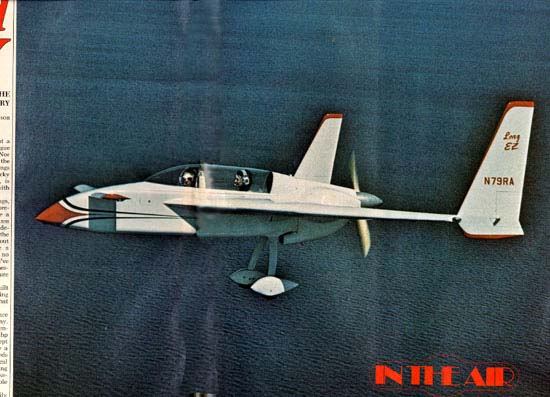
PIREP: Long EZ
Budd Davisson, Air Progress, December 1980

What, you may ask, is a Long EZ? It is not a hold over from an old John Wayne dialogue ('Okay, pilgrim, jest get a Long EZ"). Nor does it refer to a very "friendly" tall girl (the rumors that all Rutan designs have sexual beginnings are false, although names like VariEze and Quicky could start people talking). What the Long EZ is, is another new Rutan exercise in foam and fiberglass with a Lycorning mixed in for flavor.
But the Long EZ is not without its shortcomings, the most serious of which is that it looks like its fore-bearer, the VariEze. It's shaped almost exactly like a VariEze. Its bones use the same foam and fiberglass sandwich technique that have become a Rutan trade-mark and the prototype is painted the same as the dozens (soon to be hundreds) of VariEzes batting about the sky. The Long EZ probably even tastes like a VariEze. But, folks, I'm here to tell that it is in no way, shape or foam----er form-a VariEze. Once you've taken it around the patch, you come down with a mes-sage literally tattooed on your brain cells, "This is sure as hell no VariEze."
Is the Long EZ better than that backward foambuilt that made Rutan a super-star in the homebuilding world? You'd better believe it is! It's just a shame that it looks so much like a VariEze.
The reasons for designing a new airplane in the face of the phenomenal success of the VariEze were many. The VariEze was designed to use the small Continentals, from 65 hp (never saw one built), to the 100 hp 0-200 and absolutely demanded that weight be kept to a minimum. It seldom was. As soon as you give a man a two-place, 180 mph traveling machine, he needs a radio, then a gyro, then a DME, then an electrical system and so forth, until the machine is carrying around 200 pounds of undesigned-for garbage. The take-off and landing performance quickly began to resemble that of a hocky puck.
Then, the 0-200 was discontinued and the".. . easily and economically available 0-200 . . ." suddenly became worth it's weight in damned near anything.
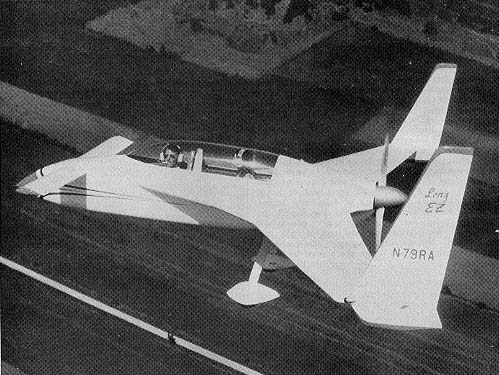
Also, as more and more people began flying VariEzes, it became apparent that Burt's taste in airplanes may or may not match everybody else's. For one thing, many pilots complained about the VariEze's foxhole visibility on landing and takeoff. Also, the stick forces were too light for many drivers, especially at low speeds, and it was very possible to make a few minor mistakes in building the canard that resulted in stick forces approaching zero when in approach mode. And the ai-plane didn't like grass fields. As a matter of fact, it even hated rough concrete. Then, Rutan himself found that his "unspinnable" design could, in certain unusual combinations of CG, weight and speeds be forced to depart into a spin.
None of this is nearly enough to condemn an airplane, in fact, many designs that are now flying make the Eze's list of minor transgressions sound like favorable comments, But, Rutan wasn't satisfied because some of his customers weren't totally satisfied. So, a new machine was designed.
The aims of the new machine were simple: Eliminate all the problems of the VariEze and incorporate the more available 0-235, 108/115 horse Lycoming and an electrical system. The 0-235 Lycoming is not a light engine, and since long range fuel capacity was another design criteria, the new airplane was going to have to be much larger than the previous one. The gross wing area, canard included, would be ninety-four square feet against sixty-six for the VariEze.
The final (more or less) version of the Long EZ flew in November of 1977 and Rutan immediately launched into an aggressive, but low buck promotion campaign. He had to. When he originally announced that he was designing a new airplane, sales for VariEze plans dropped to zilch and his cash flow followed. Still, he preferred to let the Long E'Z speak for itself. So, rather than dropping big bucks on lavish advertising, he put the Long EZ to work proving itself. First on the list of things to do was the establishing of a long distance record for its class. And what a record! Brother Dick Rutan saddled up with an auxiliary fuel tank in the back seat and droned back and forth over an officially measured course until he had flown 4,800 statute mites in thirty-three and a half hours. One of the deciding factors to end at 4,800 miles was that after so many hours without sleep, Dick was beginning to hallucinate. If he had been willing to borrow a couple of greenies from a trucker, he could have added a pretty good chunk to the distance. Now, here's an airplane that can outlast any pilot.
His second method of telling the Long EZ story to the world was to make certain brother flick showed up at any fly-in where more than three airplanes were in attendance. His route of flight was always the same nonstop. He even planned far enough ahead that his nonstop California to Oshkosh jaunt had him arriving during the Airshow
Then, Dick came up with an airshow routine for the Long EZ. It didn't cause Pitts pilots to drop their gum, but it definitely showed the Long EZ's ability to ca- vort. Besides the normal loop-and-roll stuff, Dick does a power-off, three-turn, descending spiral that starts at maybe 300 feet and finishes in a landing. It may not sound like much, but until you see him start those turns at that low an altitude, you won't believe how clean an airplane can be.
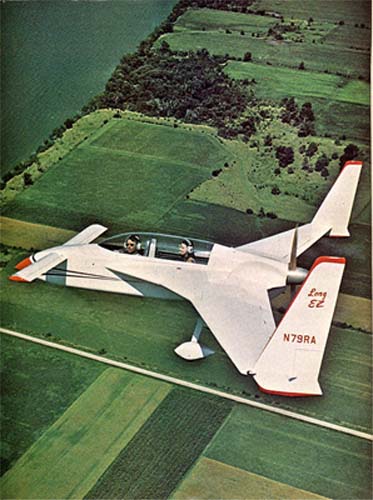 Since the VariEze
had gained a reputation as being a little on the toasty side for
the average pilot, Rutan began strapping everybody in sight into
the Long EZ so they could see the difference. When I flew the
airplane at Oshkosh in August, I was number thirty-three to check
out in it and the number probably broke forty before the end of
the week. The really important (and impressive) part of the Long
EZ guest book is that it includes signatures from a lot of folks
who hardly qualify as hot rock pilots. Like Ms. Pat Storch, for
instance, a twenty-four hour student pilot who soloed it with
only six landings and one hour of dual, and Sally Melvill, Rutan's
office manager, who had only 100 hours under her belt before she
hopped in it and disappeared.
Since the VariEze
had gained a reputation as being a little on the toasty side for
the average pilot, Rutan began strapping everybody in sight into
the Long EZ so they could see the difference. When I flew the
airplane at Oshkosh in August, I was number thirty-three to check
out in it and the number probably broke forty before the end of
the week. The really important (and impressive) part of the Long
EZ guest book is that it includes signatures from a lot of folks
who hardly qualify as hot rock pilots. Like Ms. Pat Storch, for
instance, a twenty-four hour student pilot who soloed it with
only six landings and one hour of dual, and Sally Melvill, Rutan's
office manager, who had only 100 hours under her belt before she
hopped in it and disappeared.
I came to fly the LongEZE in a rather unusual sort of way. sort of way. I was moseying around Oshkosh when I heard myself being paged over the speaker system.
The whole world, or at least the part that was at Oshkosh, knew that I was being ordered to report to the Long EZ. I found Dick Rutan hovering around the air-plane, its nose on the ground like a praying mantis. He saw me coming and motioned me over. "Well," he said, "This is a good time to try it on" Talk about lack of preparation! I had "mentioned" to Burt that I was giving a seminar later in the week comparing various homebuilt types and how they flew. I told him I knew everybody was going to be curious how the Long EZ flew and it was a shame we didn't have enough time to check me out. As I stood there beside the Long EZ, Dick Rutan pointing out this gadget and that, it looked as if there really was time after all.
In climbing into the Long (we'll call it by its first name), several things are immediately apparent: First of all, it's significantly bigger inside. I never did con-sider the VariEze too tight, but the Long gives you enough room to squirm around in. Since I'm a very average 5 foot 10 inch pilot type person, I'd have to say that the Long probably has no limitations in terms of pilot size, flick Rutan looks to be a couple inches over six feet, and he fits fine, but they did have to adjust the rudder pedals and seat cushion for me.
Another immediately apparent change-and one that was very welcome-is the gear system. Once I was strapped in Dick picked the nose up by the canard (it had been sitting on its nose), and I cranked the nose gear down. Earlier VariEze's had a single stroke lever affair protruding from the panel that I never did like. It was too hard to actuate, wasn't terribly positive and, in case of a crash, was a sword pointed directly at your chest. Later VariEzes got the crank system now standard on the Long. You just crank it until it stops and that's it. Up and down indications are simpla If you can't move the crank in one direction, the gear is down if it won t move the other way, it is up- A properly raucous sounding horn lets you know when you've cut the power too far with the nose gear still tucked in
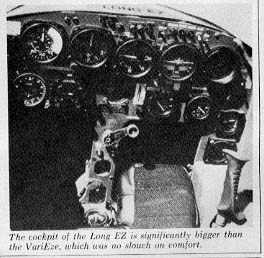 With
the canopy down and locked, I threw the master and one mag switch,
and Dick threw the 0-235 through one blade. The Lycoming knew
better than to balk, thereby risking Dick's wrath, so it barked
into lifa, and Dick slid over the wing root and into the back
seat.
With
the canopy down and locked, I threw the master and one mag switch,
and Dick threw the 0-235 through one blade. The Lycoming knew
better than to balk, thereby risking Dick's wrath, so it barked
into lifa, and Dick slid over the wing root and into the back
seat.
Taxiing is essentially a game played with the brakes and throttle. Since the nose wheel is full swivel and friction locked to center, you have to be firm on the brakes to be certain ot placing the nose exactly where you want it. It's no big deal and its ground handling is better than a Yankee with its similar setup. At first I had a little problem locating the brake pedals because there aren't any. You get brake by depressing the rud-der pedal clear to the bottom, the brakes getting into the act at the bottom of the stroke. Since the rudders are totally independent of one another, you taxi along with both of them deflected outwards as you keep the rudders depressed to the point that the brakes are only an inch or so of travel away.
In case you haven't been to Oshkosh and flown off the fly-by runway, you've missed one of life's real thrills. They run thousands of takeoffs and landings each day, none of them with radios and with next to no problems. You taxi up to a couple of Feds standing by the side of the runway with orange paddles in their hands. They watch final for you and when they see an open slot, they quickly wave you out. It's almost like being on a land-locked carrier. Slam, barn, thank you ma'am! They don't waste any time and they don't worry about intervals.
The guy with the paddles pointed both of them at me and motioned toward the runway, meaning I was to take position on the centerline. I poked the Long in the rear (the only place you can poke a pusher), and it begrudgingly worked its way up the incline through the grass. I was a little slower than the second Fed wanted me to be because of a plane on final. He made a frantic paddle signal that could only be interpreted as "Cleared for immediate, repeat immediate, takeoff." I started the power up in the turn and had full power by the time we hit the centerline.
I WAS JUST A BIT GOOSEY ABOUT THE BRAKES-only steering and concentrated on keeping the nose right on the dotted line. A quick glance inside showed me coming up on fifty knots, so. I tightened my grip on the side stick and eased it back. My only experiences with side sticks had been in the BD-5 and VariEze, and both of them taught me to be gentle or I'd over-control. The Lung didn't demand that kind of tender-ness. Even as the nose wheel came up and we were still running on the main, it was evident Rutan had learned something in the past few years. Even at that low speed, the pressure gradient in the stick was building and my right hand could tell it was holding onto something.
At about sixty knots, the Long was off the runway and I had my first and most pleasant surprise . . . I could actually see where I was going. Believe me, that was definitely not the case in the VariEze. The seating position doesn't appear that much different, but it obviously is. Also, the aerodynamics of the Long are such that the deck angle on rotation must be a little flatter. Whatever it is, the visibility is next to fantastic. It's as good, or better than any tricycle airplane I know of.
Then I made a quick turn onto crosswind and got my second surprise : gheesus does this thing ever roll!! It actually caught me with my drawers down.
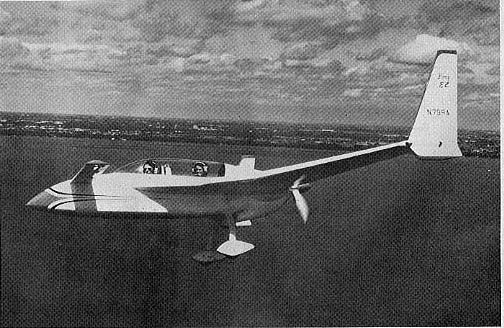
With a very normal amount of side pressure and stick displacement, I found myself whipping to one side as if I was in my Pitts. The pressures are just right, the stick travel is fine and the response is not to be be-ieved. The VariEze had been okay in the controls department, but the Long is close to perfect. Even though I had just cranked the gear up and hadn't even left the pattern yet, I was in love. Damned, if it just had another wing to make it a biplane!
Dick said the normal best rate of climb speed was ninety knots, but I used 100 so I had a better chance of seeing the dozens of airplanes I knew were out there. Oshkosh is not the place to be charging around with your head down and locked.
We were climbing at about 1,100 fpm, so we punched through 8,000 feet in nothing flat. As I pushed over for level flight, I kept cross checking the altimeter and the airspeed, trying to establish level flight . . . which ain't easy. Level looks nose down to me. Really nose down! At about 2,600 rpm we wound up indicating 160 miles for a true of about 165 mph. Rutan gives the max 75% cruise as 191 mph TAS at 8,000 feet. Economy cruise is 165 mph, which is good for a 1,400 mile range with both seats full, standard fuel and baggage.
As the speed built up, the stick pressures increased only slightly, if at all, but the stability began to ap-proach that of a living room sofa. At slower speeds it seemed stable, but you still had to pay attention to it. At crwse speeds, you forget about it. Flat forget it! I ran it up to twenty mph over cruise speeds, quickly releasing the stick. The nose came back up, overshot, then back down, then stabilized at the end of the second cycle. It was equally stable on the other two axis. It appears to move only if you ask it to, otherwise it will keep on trucking straight ahead forever or until it runs out of gas, whichever comes first.
Having seen Dick's routine, and now having tasted the Long's ailerons, I just had to roll it. So, I did. A slow, gentle, positive C aileron roll in the Long is so silky you'd think you were in a jet.
SINCE I KNEW I WAS GOING TO HAVE TO LAND IT eventually, I chopped the power, and dropped the gear to get a feeling for Its slow speed manners.
'Then I got yet another surprise, this one not necessarily good but not bad either: I couldn't slow it down. The prototype doesn't have the bellyboard drag flap of the production models and no airplane ever needed one more! Even power off, it was a real bitch to get down to the approach speed of 65 knots. This was going to be something to remember in the pattern.
I put the nose on the horizon, power off, rolled left, and kept bringing the stick back. Actually, I got the stick back on the stop almost immediately, but the air-plane kept on flying. The nose bobbed up and down a little bit, but no amount of yanking could get the stall to break. It also demonstrated little or none of the dutch roll tendency of the VariEze's stall. I would imagine there is a combination of full-aft stick and power that would let you come down to a survivable crash/ landing in a weather or night emergency situation.
I kept the gear out (which incidentally doesn't slow it down at all), and headed down to Fond du Lac to shoot some landings, keeping in mind the way this bird wants to hang onto speed. Making a long forty-five degree to the downwind, I got it down to 100 and then ninety on downwind. But ninety is a long, long way from sixty-five in a Long EZ. Fortunately (I Thought) there was a Cherokee in front of me, so I extended my pattern and finally got down to sixty-five indicated. Dick's voice came up in the headset, "We'll never make it, we're too high." I looked back at the runway and thought he was crazy. Still, I flew out far enough before turning base that I figured I'd be able to use a little power on final to control glideslope and paste it right on the numbers. Then I turned final. Wait a damned minute! I was on a long final and at sixty-five knots, but I wasn't coming down. To make a long story short, I wouldn't have hit any part of a 4,500 foot nmway. EMBARRASSING! Dick was chuckling softly through the hot intercom system.
Next time around I had the speed nailed on down-wind and didn't use power anywhere for anything. I moved base leg out still further and even then, I had my doubts about getting down. I was even standing on both rudders trying to use them as tiny drag brakes. Then I saw we were going to get down, so I started trying to establish visual references for the flare. I couldn't find any! As the runway came up to meet us, I figured the best I could do would be to hold it off and keep holding it, letting it establish its own attitude at touchdown. Gingerly, and I do mean gingerly, I brought the nose up a little, then when I appeared to be level, it stopped settling. Then it settled a little and I eased back. Still, we were in a level attitude. Back a little more and we still appeared to be level. Clunk! We were down, and the nosewheel wasn't touching and I still thought we looked level. Then I started to lower the nose. Oh my God! My heart jumped up into my throat as the nose continued down, down, and I had the sickening feeling I had known once before . . . when the nose gear on a VariEze had failed and I fell on my nose. Not again! Then, clunk! The nose gear was there all right, but the cold sweat on my neck reminded me how scared I'd been. The nose sits so far down on rollout that you actually have the feeling you're falling on your schnoze, something my schnoze couldn't stand again.
Power on, around we went again, this time, I was a little more ahead of the airplane and beginning to enjoy it even more. I was reminded by Dick that I was doing what most other first-time Long pilots do, taking off with at least one rudder sticking out. And that's one criticism I have of the airplane, minor though it may be. The rudder pedal travel is something like five inches with the brakes being the last inch. Since you're using brakes for directional control during part of the takeoff run, you have to mentally remind yourself to move your feet a long way aft to keep from depressing a rudder
Another minor complaint is that the rudders have a little too much rudder pressure when you are at cruise speed. The short, wide chord rudders react very quickly to increasing G which puts them out of harmony with the rest of the controls at higher speeds. Burt did this to make the airplane that much more unspinnable, since you really have to be standing on the rudders to get them very far out in the wind. It does present a minor imbalance, however, but one you can certainly live with.
The Long EZ is going to be as important as the Vari-Eze was, but in different ways. The VariEze established the nioldiess, foam/glass sandwich techniques as being a truly practical, safe way to build airplanes. The Long EZ is going to set standards for any machine which pretends to be a cross-country nmner. The big wing strakes of the Long contain enough fuel and baggage that any couple can easily use the airplane as though it was a Bonanza. The cruise speeds and excellent inherent stability make it a great XC bomber, and the seats are super comfortable, although the rear passenger will find room for his feet a little cramped. The real advantage to the Long EZ will become apparent when you taxi up to the gas pump after running ten hours non-stop California to Oshkosh and the final numbers on the gas pump are $79! It's going to be a long time before that number is beaten!
.